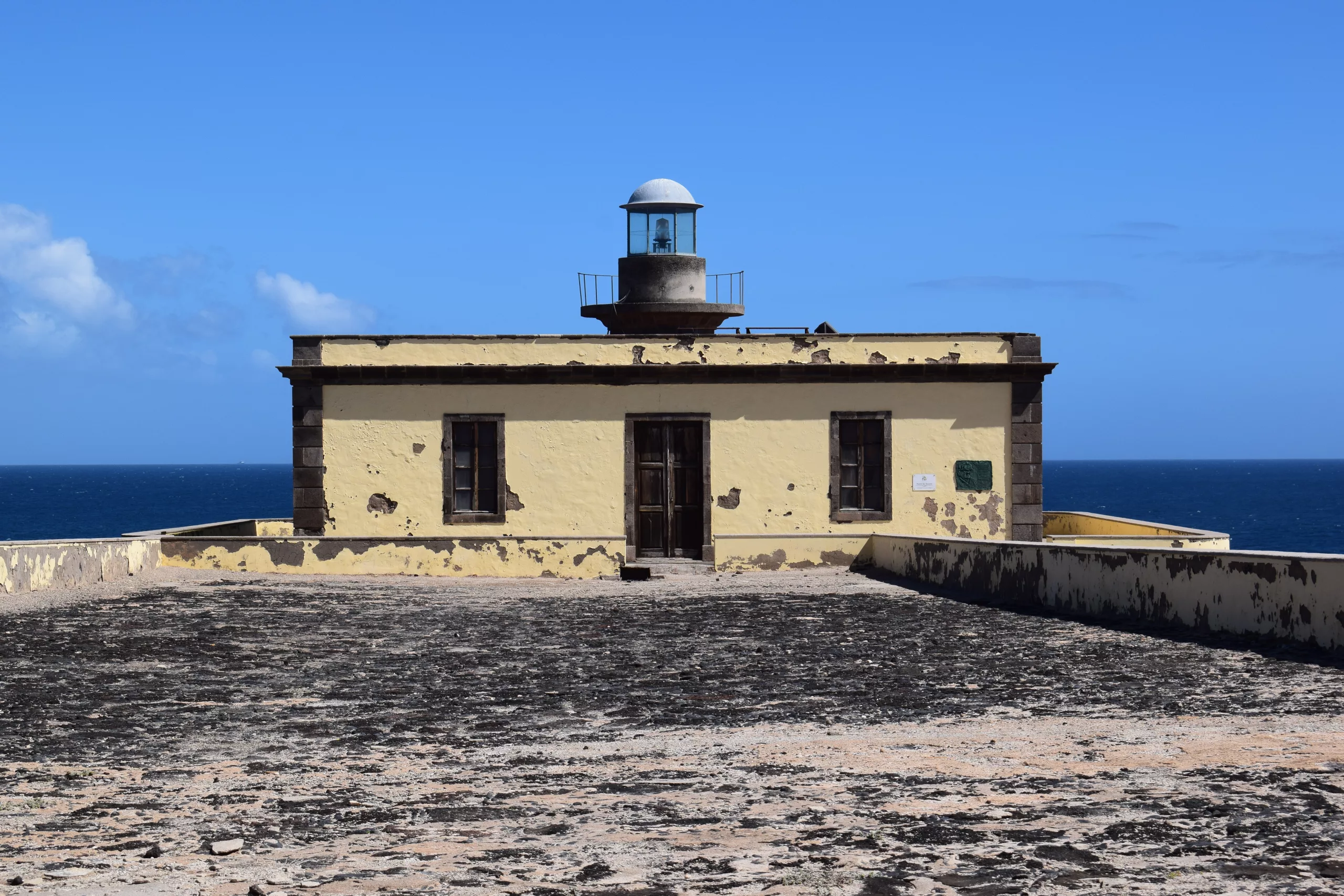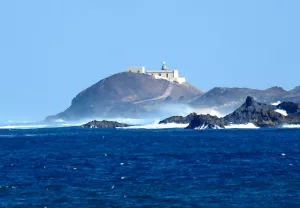The Punta Martiño Lighthouse, located on the small and serene island of Lobos, near Fuerteventura, is a historical landmark of great relevance in the Canary Islands. This lighthouse has not only been a crucial element in the safety of maritime navigation, but has also played a significant role in the history and cultural development of the region. Through its long existence, it has seen changes in navigation technology, been home to generations of lighthouse keepers and inspired artists and writers.
History and construction of the lighthouse
The Punta Martiño Lighthouse, built in the second half of the 19th century, is a monument that encapsulates the rich maritime history of the Canary Islands. Its construction was a direct response to the growing need for safe navigation systems at a time when maritime traffic between the islands and the European continent was booming. Designed with a robust and functional architecture, typical of the time, the lighthouse was erected not only as a navigation tool but also as a symbol of progress and modernization. The materials used, mainly local stone and lime, were chosen for their durability and resistance to adverse marine conditions. The construction of the Punta Martiño Lighthouse was an ambitious project that required the collaboration of engineers, architects and local workers, reflecting a period of great technological and cultural development in the Canary Islands.
The age of navigation and its importance
During the 18th and 19th centuries, navigation was the main means of trade and communication between the Canary Islands and the rest of the world. In this era, ships relied heavily on lighthouses to navigate the dangerous waters of the Atlantic. The Punta Martiño Lighthouse, with its powerful and constant light, became a lifeline for sailors, significantly reducing the risks of shipwreck and loss of life and goods. This period marked a boom in maritime trade, with a notable increase in the import and export of products such as wine, textiles and agricultural products. The lighthouse not only facilitated trade, but also played a crucial role in the safety and efficiency of transatlantic travel, contributing significantly to the economic development of the region.
Lighthouse triangulation as an innovative navigation system
The triangulation of the Punta Martiño, La Entallada and Tostón lighthouses was a notable innovation in the history of maritime navigation. This system allowed ships to determine their exact position at sea, an invaluable tool in a time before GPS technology. The accuracy of this triangulation was crucial for safe navigation, especially in the notoriously difficult waters around the Canary Islands. This method not only improved safety, but also increased the efficiency of sea routes, allowing ships to optimize their trajectories and reduce travel time. The implementation of this triangulation system was a testament to human ingenuity and a milestone in the history of navigation.
Impact at a cultural and social level
The Punta Martiño Lighthouse is a cultural and social icon of the Canary Islands. Their presence has deeply influenced the lives of local communities over the years. The lighthouse has not only been a guardian for sailors, but also a meeting point for the island’s inhabitants, symbolizing the connection between land and sea. The stories and legends surrounding the lighthouse, many of them transmitted orally, reflect the intimate relationship between the community and its maritime environment. The lighthouse has witnessed numerous historical events, from naval conflicts to changes in trade routes, and has been a constant reference point in the cultural and social evolution of the region. Its impact goes beyond its practical function; It is a symbol of the identity and heritage of the Canary Islands.
How to get to the Punta Martiño Lighthouse by the best route
The best way to get to the Punta Martiño Lighthouse on Isla de Lobos in Fuerteventura is to board the ferry to Isla de Lobos (Buy tickets) and once you disembark at El puertito Isla de Lobos, you have to head north, passing through Las Lagunitas, El Aljibe Grande and Playa de la Arena, below we attach the route through Google Maps, with a duration of approximately 50 minutes.
Conservation and tourism
The conservation of the Punta Martiño Lighthouse is essential to preserve not only an architectural landmark, but also a piece of the maritime history of the Canary Islands. Over the past few decades, there has been a concerted effort to maintain and restore the lighthouse, ensuring that its structure and machinery remain in good condition. These conservation efforts have been key to transforming the lighthouse into a tourist attraction. Visitors are attracted not only by its history and architectural beauty, but also by the opportunity to experience panoramic views of the ocean and island. The tourism generated by the lighthouse contributes significantly to the local economy, and its presence has stimulated the development of related activities, such as guided tours, historical exhibitions and cultural events. The Punta Martiño Lighthouse is not only a monument of the past; It is a living resource that continues to enrich the cultural and economic life of the region.
The life of the lighthouse keepers
The life of the lighthouse keepers at the Punta Martiño Lighthouse was a mix of isolation, responsibility and deep connection with the sea. These lighthouse keepers lived in austere conditions, often for long periods, away from their families. Their job was essential but challenging, requiring constant maintenance of the lighthouse and surveillance during all hours, regardless of weather conditions. The life of a lighthouse keeper was marked by a rigorous routine, focused on ensuring that the lighthouse light never went out. Despite the difficulties, many lighthouse keepers developed a deep bond with the lighthouse, seeing it as a silent companion and constant witness to their lives. Their stories and experiences offer a fascinating window into a way of life that has largely disappeared in the modern era.
Technology and evolution
Over the years, the Punta Martiño Lighthouse has undergone several technological upgrades, reflecting advances in lighthouse technology. Originally, the lighthouse used oil lamps, which required constant attention to maintain light. Over time, these were replaced by more efficient lamps and eventually by electrical technology, which significantly increased the intensity and reliability of the light. These technological advances not only improved the effectiveness of the lighthouse as an aid to navigation, but also reduced the workload of lighthouse keepers. The final automation of the lighthouse marked the end of an era, transforming the traditional role of the lighthouse keeper and bringing the lighthouse into the modern era of navigation.
The lighthouse in literature and art
The Punta Martiño Lighthouse has been a source of inspiration in literature and art, capturing the imagination of artists and writers over the years. Its imposing presence and connection with the sea have made the lighthouse a recurring theme in paintings, photographs, poems and novels. Artists have portrayed the lighthouse in different lights and seasons, capturing its ethereal beauty and resistance against the elements. In literature, the lighthouse has often been symbolized as a place of reflection, solitude and hope, reflecting human emotions in their relationship with the sea. These artistic and literary representations of the Punta Martiño Lighthouse not only celebrate its beauty and historical significance, but also contribute to its legend and mysticism, further enriching its cultural legacy.
The Punta Martiño Lighthouse is a vital testimony of the maritime and cultural history of the Canary Islands. Its importance transcends its original function as a navigation guide, becoming a point of historical, tourist and educational interest. The preservation of this lighthouse and the growing interest in its history ensure that its value, both to the local community and visitors from around the world, will remain alive and recognized for years to come.


